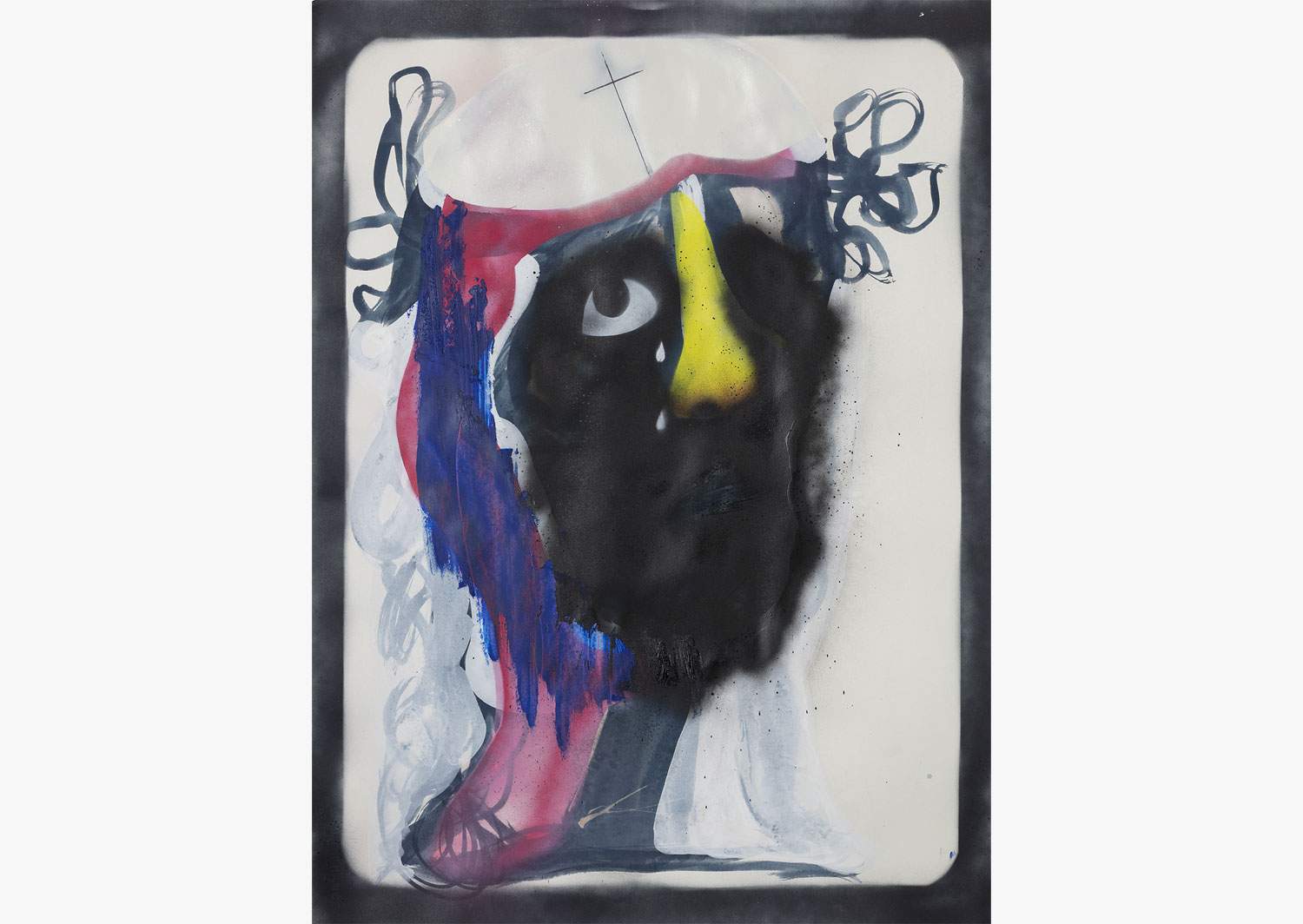The art of Alessandro Pessoli (Cervia, 1963), one of Italy’s leading contemporary artists, arrives at the Cloisters of Sant’Eustorgio in Milan: from September 15 to November 28, 2021, the public will be able to visit Testa cristiana, an exhibition itinerary conceived by Pessoli and curated by Eva Fabbris, composed of about fifteen works, including previously produced works and works conceived for this context, designed to significantly dialogue with the different spaces of the cloisters and with some specific architectural and furnishing elements that connote them.
The exhibition opens with the presence in the Chapter House of the Museum of the Basilica of Sant’Eustorgio of some pictorial works produced between 2008 and 2019, while the Sacristy and the spaces in front of the Portinari Chapel host works conceived specifically in dialogue with the space. Again, in the Paleochristian Cemetery, a 2008 majolica tile introduces the theme of the body, presented in pieces as in the reliquaries and tombs in the midst of which it is displayed; the same investigation is continued by another work made recently for this place. The exhibition continues in the section dedicated to the goldsmithing and liturgical furnishings of the Carlo Maria Martini Diocesan Museum where the precious concentration of the museological itinerary corresponds to the final part of the exhibition, with a series of sculptures of heads including a ceramic piece thought to be related to the polychrome stucco tondo dating back to the mid-10th century, depicting St. Ambrose blessing a half-length preserved in the Museum.
The opportunity to exhibit in a context of great importance for Christian history and culture, for the history of art, as well as partly still connoted by liturgical activity, allowed Pessoli to articulate anexhibition that intends to reflect and narrate his conception of sacredness, confronted with contemporary living, with the need to live with pain and insecurity, as the artist himself recounts in conversation with Barbara Casavecchia: “I load the image with tension, because I want it to be expressive, because for me it is not pacified. It is reality that is difficult, even violent. I would like to make serene work, without drama, but I love to excite the images for feedback. [...] I used subjects from the Catholic iconographic tradition precisely because I found them difficult, capable of resistance, and the attempt to find a balance became interesting.”
In his practice, the artist regularly uses different mediums, particularly painting and sculpture, with a predilection for ceramics; the exhibition itinerary designed for Sant’Eustorgio testifies to the variety of materials and techniques that characterizes his production. In Pessoli’s works, the representation of the human figure recurs, through which he addresses themes of an existential nature: historical figures, classical iconographies of art history, and images of everyday life are mixed in a dreamlike, sorrowful, and at times grotesque reconstruction of reality, never free of an instinctive sentimental dimension. In the artist’s iconography the religious element enters particularly since the late 2000s, with works that take up themes and images from the life of Christ. For example, he participated in the 53rd Venice Biennale (2009) with a series of drawings with a religious subject, and his solo exhibition at the Collezione Maramotti in Reggio Emilia in 2011 also focused on a trilogy of large paintings evoking some narratives from the New Testament. When the reference to the sacred is less direct, the representation of the emotional and psychic life of the individual is always at the center of his making. A lavishly illustrated catalog with photographs of the installation, containing texts by Eva Fabbris, Giuseppe Frangi, Nadia Righi and Alexis Vaillant and a conversation between artist Pier Paolo Campanini and Alessandro Pessoli, will be published by Lenz Press (Milan) during the duration of the exhibition.
Alessandro Pessoli, who lives and works in Los Angeles, has addressed various themes in his production, including politics, religion, history, culture and identity.His work is characterized by the use of drawings, paintings and sculptures that often depict expressive and seemingly melancholy figures within isolated and indeterminate spaces. Throughout his career he has held solo exhibitions at institutions and galleries such as: Palazzo Vizzani, Bologna (2021); Anton Kern Gallery, New York (2017 and 2021); Greengrassi, London (2020); Nino Mier, Los Angeles (2019); Xavier Hufkens, Brussels (2018); Marc Foxx Gallery, Los Angeles (2017); MAN, Nuoro (2016); Palazzo della Triennale di Milano, Milan (2015-2016); Villa Paloma, Nouveau Musée National de Monaco, Monte Carlo, Monaco (2015); San Francisco Museum of Modern Art (2012); Collezione Maramotti, Reggio Emilia (2011); Nottingham Contemporary, Nottingham (2010). His work has also been presented in numerous group exhibitions, including: Fondazione Stelline, Milan (2017-2018); DESTE Foundation, Centre for Contemporary Art, Athens (2013); Museum of Contemporary Art, Chicago (2009); XIV, Quadriennale di Roma, Rome (2009). A series of drawings with a religious theme was exhibited at the 53rd Venice Biennale curated by Daniel Birnbaum in 2009.
Pictured: Alessandro Pessoli, Christian Head #1 (2018; Oil, ink, bleach, tempera, spray paint, oil pastels; Private collection). Photo: Roberto Marossi
 |
| Christian head: Alessandro Pessoli on display at the Chiostri di Sant'Eustorgio in Milan |
Warning: the translation into English of the original Italian article was created using automatic tools. We undertake to review all articles, but we do not guarantee the total absence of inaccuracies in the translation due to the program. You can find the original by clicking on the ITA button. If you find any mistake,please contact us.